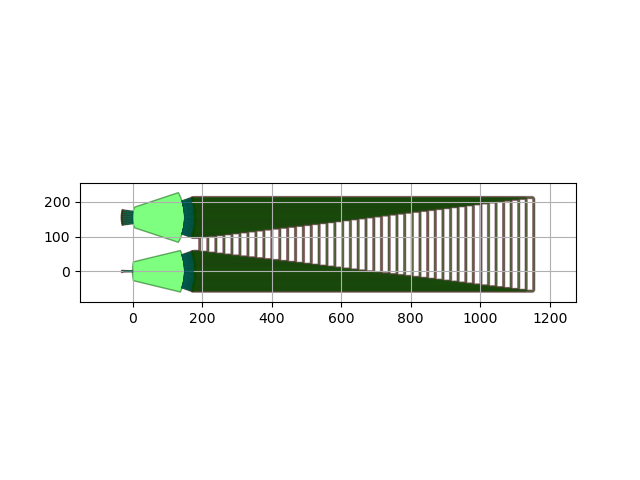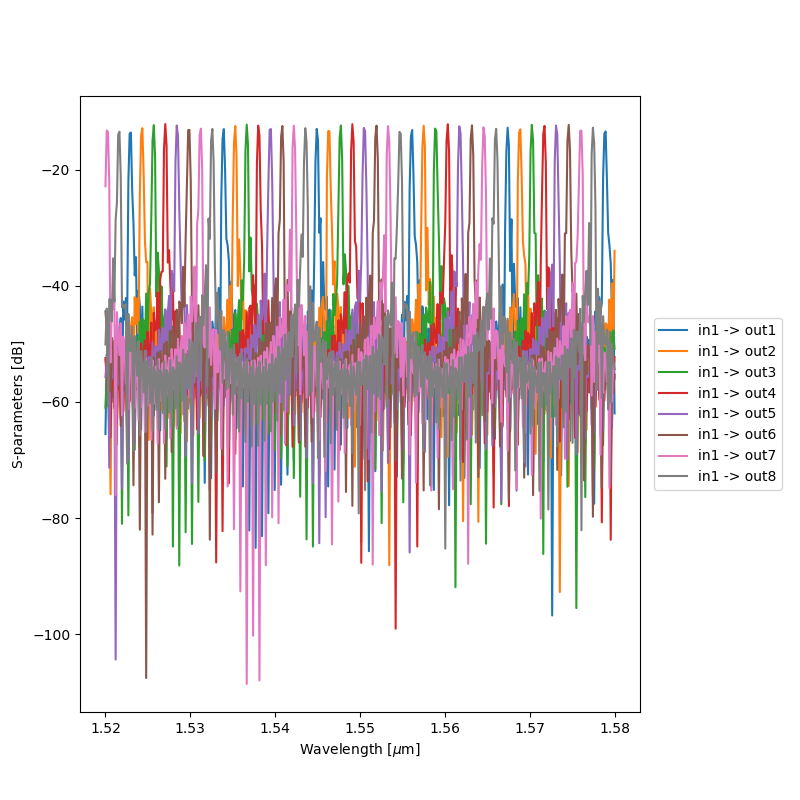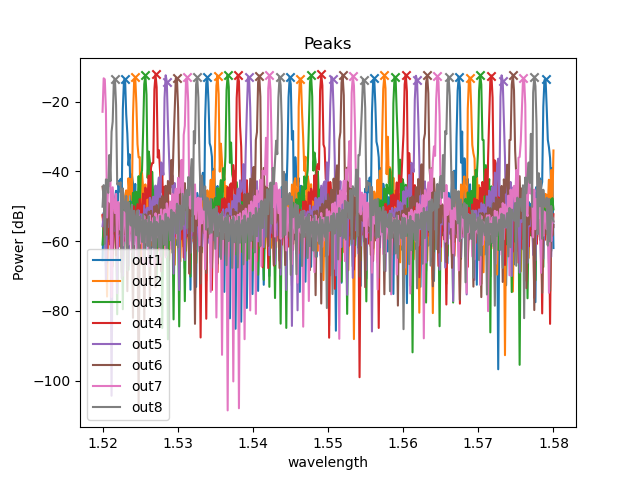Note
Go to the end to download the full example code
Make a Rectangular AWG
This simple example illustrates how to make a rectangular AWG and how to run a Caphe simulation on it. For this example, we use the Luceda AWG Designer module.
Getting started
We start by importing the technology with other required modules:
from si_fab import all as pdk # noqa
from ipkiss3 import all as i3
import numpy
import awg_designer.all as awg
from si_fab_awg import all as awg_pdk
Next, create a template for the free propagation region. This defines the layers, slab modes, etc.
The aperture
Make a virtual aperture
ap = awg_pdk.SiRibAperture(
slab_template=slab_t,
aperture_core_width=W,
aperture_cladding_width=1.0,
)
ap_lo = ap.Layout()
ap_sm = ap.FieldModelFromCamfr()
ap_cm = ap.CircuitModel(simulation_wavelengths=[1.55])
The input star coupler
Make a multi-aperture for the arms consisting of N apertures like these, arranged in a circle and get the transformations of the individual apertures.
angle_step = i3.RAD2DEG * (W + 0.2) / R
angles_arms = numpy.linspace(-angle_step * (N - 1) / 2.0, angle_step * (N - 1) / 2.0, N)
ap_arms_in, _, trans_arms_in, trans_ports_in = awg.get_star_coupler_apertures(
apertures_arms=[ap] * N,
apertures_ports=[ap],
angles_arms=angles_arms,
angles_ports=[0],
radius=R,
mounting="confocal",
input=True,
)
Make the input star coupler
sc_in = awg.StarCoupler(aperture_in=ap, aperture_out=ap_arms_in)
sc_in_lo = sc_in.Layout(
contour=awg.get_star_coupler_extended_contour(
apertures_in=[ap],
apertures_out=[ap] * N,
trans_in=trans_ports_in,
trans_out=trans_arms_in,
radius_in=R,
radius_out=R,
extension_angles=(10, 5),
)
)
sc_in_lo.visualize()

The output star coupler
Make the multi-apertures for the outputs and get the transformations for the individual apertures.
angle_step = i3.RAD2DEG * (4.7) / R
angles_ports = numpy.linspace(angle_step * (M - 1) / 2.0, -angle_step * (M - 1) / 2.0, M)
ap_arms_out, ap_out, trans_arms_out, trans_ports_out = awg.get_star_coupler_apertures(
apertures_arms=[ap] * N,
apertures_ports=[ap] * M,
angles_arms=angles_arms,
angles_ports=angles_ports,
radius=R,
mounting="rowland",
input=False,
)
Make the output star coupler
sc_out = awg.StarCoupler(aperture_in=ap_arms_out, aperture_out=ap_out)
sc_out_lo = sc_out.Layout(
contour=awg.get_star_coupler_extended_contour(
apertures_in=[ap] * N,
apertures_out=[ap] * M,
trans_in=trans_arms_out,
trans_out=trans_ports_out,
radius_in=R,
radius_out=R / 2,
extension_angles=(10, 10),
)
)
sc_out_lo.visualize()

The rectangular waveguide array
Make the RectangularWaveguideArray
The Arrayed Waveguide Grating
Make an AWG with the 3 building blocks
rect_awg = awg.ArrayedWaveguideGrating(
star_coupler_in=sc_in,
star_coupler_out=sc_out,
waveguide_array=waveguide_array,
)
awg_lo = rect_awg.Layout()
awg_lo.visualize()

Running the Caphe simulation
print("Running Caphe simulation (with wavelength-independent star couplers)")
sc_in.CircuitModel(simulation_wavelengths=[1.55])
sc_out.CircuitModel(simulation_wavelengths=[1.55])
awg_cm = rect_awg.CircuitModel()
wavelengths = numpy.linspace(1.52, 1.58, 401)
import time # noqa
t0 = time.time()
S = awg_cm.get_smatrix(wavelengths)
print("Calculation time:", time.time() - t0)
term_pairs = [("in1", f"out{i}") for i in range(1, M + 1)]
S.visualize(term_pairs=term_pairs, scale="dB")

Running Caphe simulation (with wavelength-independent star couplers)
Calculation time: 22.821743726730347
Using SpectrumAnalyzer to analyze the results
We finally use i3.SpectrumAnalyzer to
detect the peaks and calculate the crosstalk.
sa = i3.SpectrumAnalyzer(
smatrix=S,
input_port_mode="in1",
output_port_modes=[f"out{i}" for i in range(1, M + 1)],
peak_method="cwt",
peak_threshold=-25,
)
sa.visualize(title="Peaks")

Let’s calculate the passbands for a cutoff of 25 dB:
bands = sa.cutoff_passbands(-25)
And then calculate the nearest neighbor crosstalk for each channel. The value reported for out1 is the crosstalk caused by the neirest channels out8 and out2:
print(sa.near_crosstalk(bands))
OrderedDict({'out1': np.float64(-31.095598863671068), 'out2': np.float64(-28.611422930946794), 'out3': np.float64(-28.814016159696212), 'out4': np.float64(-29.48431541767117), 'out5': np.float64(-29.5518724332548), 'out6': np.float64(-28.903041140937297), 'out7': np.float64(-28.49383881700645), 'out8': np.float64(-33.17156186755648)})
We also calculate the far neighbor crosstalk, which ignores nearest neighbors:
print(sa.far_crosstalk(bands))
OrderedDict({'out1': np.float64(-34.90981139935744), 'out2': np.float64(-34.86976457153369), 'out3': np.float64(-35.58221686803515), 'out4': np.float64(-35.605973983515476), 'out5': np.float64(-35.59944033310276), 'out6': np.float64(-35.22360814105565), 'out7': np.float64(-34.659253434511925), 'out8': np.float64(-36.0433320104029)})